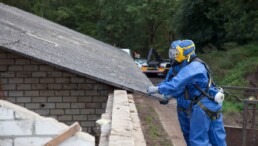Lung cancer is the second most common cancer in both men and women in the United States and happens when cells in the lung mutate or change. Most often, this change occurs as a result of people breathing dangerous, toxic substances, including asbestos. Many people don’t consider that their lung cancer could be due to asbestos exposure and might be a rare form of cancer called mesothelioma. Even 30 years after peak asbestos use in the United States, around 3,000 people are diagnosed with mesothelioma every year.
Since the only confirmed cause of mesothelioma in the U.S. is exposure to asbestos, we urge you to think about possible past exposure, even if you believe you have never been in contact with asbestos.
Learn more about the symptoms and diagnosis of mesothelioma and speak to your doctor if there is even a small chance your lung cancer might be due to asbestos. If your disease is, in fact, mesothelioma, you could have a viable legal claim: mesothelioma patients are still benefiting from life-changing verdicts and settlements in mesothelioma lawsuits in Massachusetts today.
Myth # 1: I Was Never Exposed To Asbestos, So I Can’t Have Mesothelioma
The fact is, no one can categorically say they have never been exposed to asbestos. Surprisingly, asbestos is still not federally banned in the United States even after the link between asbestos fibers and life-threatening respiratory ailments, including mesothelioma, lung cancer, and asbestosis became broadly known. By the 1970s, the hazardous effects of asbestos exposure were well documented and yet some companies continued to use asbestos-containing products and failed to protect their workers from exposure.
More than 3,000 known products contained asbestos, most of which didn’t explicitly state that they contained asbestos. From household items to furnishings to cosmetics, asbestos often lies hidden where you’d least expect it. But asbestos is most commonly found in a wide range of building materials, friction products, heat-resistant fabrics, valve packing, gaskets, and coatings, and people who regularly worked with these and other manufactured products, especially prior to the 1970s, are at elevated risk of having been exposed to asbestos. Read more about common jobs associated with asbestos exposure and why veterans, especially navy veterans, are at higher risk. With so many companies continuing the use of asbestos even after it was deemed unsafe, we urge you to remain vigilant about your lung health. If you suspect you may have been exposed to asbestos in the past, please inform your doctor immediately so they can monitor for symptoms.
Myth #2: I Worked Around Asbestos Years Ago, But It Didn’t Affect Me
Unlike a case of poison ivy, where you break out in a tell-tale rash as soon as you’ve been exposed, asbestos exposure does not produce an immediate reaction. Mesothelioma has a long latency period and typically takes 20-50 years from initial exposure to develop. Sadly, it is often just as workers are set to enjoy their retirement years that they are diagnosed. Since many of the symptoms are similar to other less dangerous illnesses, such as pneumonia, flu, or intestinal issues, it often goes undiagnosed until it has reached the later stages of the disease.
If you or someone you know has experienced any of the symptoms of mesothelioma, we encourage you to seek medical attention right away. It is critical to let your doctor know as early as possible that you may have been exposed to asbestos during your working years. Even if you aren’t currently experiencing any symptoms, ask your doctor to set up regular monitoring.
Myth #3: Only People Directly Exposed to Asbestos Are At Risk
While those exposed directly to airborne asbestos fibers are at the highest risk for developing mesothelioma, family members can also be at risk via secondary exposure to fibers brought home on the clothing of the primary individual. We have seen instances of mesothelioma in wives who routinely did their husband’s asbestos-covered laundry, or in children who hugged dad every day as he came home from work in clothes embedded with asbestos fibers. Asbestos fibers can also linger in the home for years and, once disturbed, pose a dangerous health hazard. While this is indeed rare, it is possible. If you or a family member have been diagnosed with mesothelioma, regardless of whether through direct or secondary exposure to asbestos, you may have a legal claim.
Myth #4: I Have Lung Cancer But It’s Probably Because I Smoke(d)
As a smoker, you may believe that your lung cancer is the result of your smoking history. If, however, you suspect that you may have been exposed to asbestos at some point in your life, you need to consider the possibility that asbestos played a part in causing your cancer. According to the American Cancer Society, lung cancer risk is much greater in workers exposed to asbestos who also smoke.
Lung cancer or Mesothelioma can be difficult to diagnose because it often presents with symptoms that are similar to benign illnesses such as pneumonia, flu, or intestinal issues. Your doctor will likely use a variety of diagnostic tools, including a physical exam, blood and tissue tests, x-rays and other imaging scans, and biopsies to determine whether or not cancer is present, and if so what kind of tumor. If cancer is diagnosed, these tests also help determine how far it has progressed and whether it has spread to other parts of the body. If you have been diagnosed with lung cancer or mesothelioma you may be entitled to financial compensation from asbestos manufacturers, even if you smoke(d).
Myth #5: Asbestos is Banned Now So I Don’t Have To Worry About Getting Sick
Asbestos is not federally banned in the United States, despite incontrovertible evidence that airborne asbestos fibers cause lung disease, lung cancers, and mesothelioma. While no longer as prevalent as it once was, examples of asbestos-containing products continue to come to light even today, including talc commonly used in cosmetics and other personal care products. In 2015, Disney- and Nickelodeon-branded crayons were found to contain traces of asbestos, as were eye shadows and powders sold by Claire’s and Justice stores as recently as 2020.
Many homes, schools and other buildings built before the 1970s have materials such as pipe covering, insulation, popcorn ceilings, and floor tiles that contain asbestos. But just because you live or work in a building built before the 1970s doesn’t necessarily mean you’re at risk. If the asbestos is contained, you are at a relatively low risk of inhaling airborne fibers. If, however, older materials containing asbestos are damaged or disturbed, for example during renovations or demolition, asbestos fibers can be released into the air and pose a dangerous health risk.
If you suspect that there might be asbestos in your home, we encourage you to have a professional evaluate your risk of exposure. Always have asbestos products inspected and repaired or removed by trained and accredited asbestos professionals.
Don’t Miss Out On The Financial Compensation You Deserve
If you think you might have a mesothelioma legal case in Massachusetts, we invite you to reach out to Shepard O’Donnell. We take the time to explain the process from beginning to end, setting realistic expectations and timelines. If you are unable to come to our offices due to health or other reasons, we will come to you to listen to your story and tell you honestly if we think you have a viable claim. We have helped hundreds of individuals and families obtain justice for their injuries, regularly obtaining settlements and verdicts in the millions. And you will never pay unless we deliver results for you.








